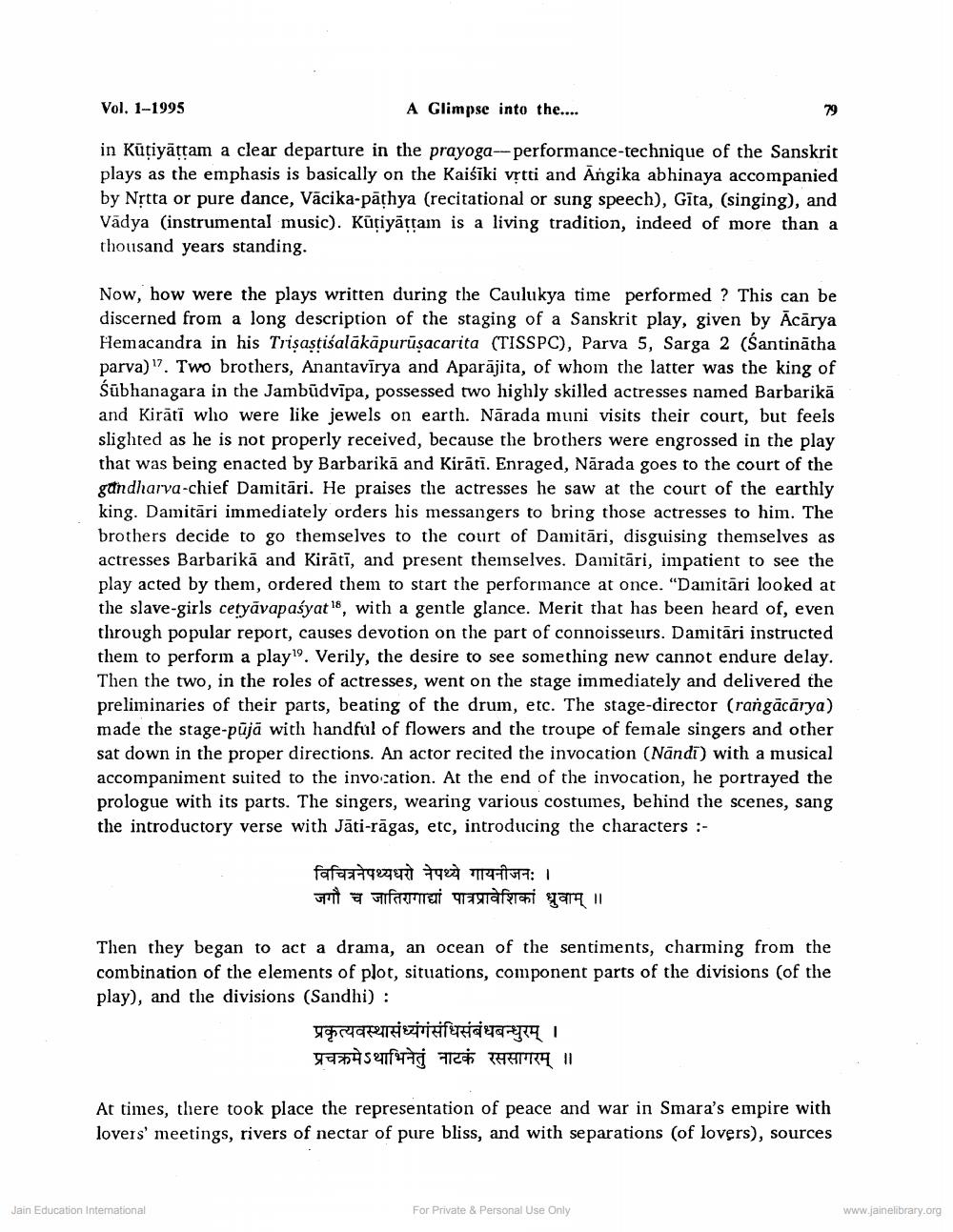________________
Vol. 1-1995
A Glimpse into the....
in Küțiyāttam a clear departure in the prayoga--performance-technique of the Sanskrit plays as the emphasis is basically on the Kaisīki vịtti and Angika abhinaya accompanied by Nịtta or pure dance, Vācika-pāthya (recitational or sung speech), Gīta, (singing), and Vadya (instrumental music). Kūriyāttain is a living tradition, indeed of more than a thousand years standing.
Now, how were the plays written during the Caulukya time performed ? This can be discerned from a long description of the staging of a Sanskrit play, given by Ācārya Hemacandra in his Trişastiśalākāpuruşacarita (TISSPC), Parva 5, Sarga 2 (Santinātha parva)". Two brothers, Anantavīrya and Aparajita, of whom the latter was the king of Śūbhanagara in the Jambūdvipa, possessed two highly skilled actresses named Barbarikā and Kirāti who were like jewels on earth. Nārada muni visits their court, but feels slighted as he is not properly received, because the brothers were engrossed in the play that was being enacted by Barbarikā and Kirāti. Enraged, Nārada goes to the court of the gandharva-chief Damitāri. He praises the actresses he saw at the court of the earthly king. Damitāri immediately orders his messangers to bring those actresses to him. The brothers decide to go themselves to the court of Damitāri, disguising themselves as actresses Barbarikā and Kirātī, and present themselves. Damitāri, impatient to see the play acted by them, ordered them to start the performance at once. "Damitāri looked at the slave-girls cetyāvapaśyat 18, with a gentle glance. Merit that has been heard of, even through popular report, causes devotion on the part of connoisseurs. Damitāri instructed them to perform a play. Verily, the desire to see something new cannot endure delay. Then the two, in the roles of actresses, went on the stage immediately and delivered the preliminaries of their parts, beating of the drum, etc. The stage-director (rangācārya) made the stage-pūjā with handful of flowers and the troupe of female singers and other sat down in the proper directions. An actor recited the invocation (Nandi) with a musical accompaniment suited to the invocation. At the end of the invocation, he portrayed the prologue with its parts. The singers, wearing various costumes, behind the scenes, sang the introductory verse with Jati-rāgas, etc, introducing the characters :
विचित्रनेपथ्यधरो नेपथ्ये गायनीजनः । जगौ च जातिरागाद्यां पात्रप्रावेशिकां ध्रुवाम् ।।
Then they began to act a drama, an ocean of the sentiments, charming from the combination of the elements of plot, situations, component parts of the divisions (of the play), and the divisions (Sandhi) :
प्रकृत्यवस्थासंध्यंगसंधिसंबंधबन्धुरम् । प्रचक्रमेऽथाभिनेतुं नाटकं रससागरम् ॥
At times, there took place the representation of peace and war in Smara's empire with lovers' meetings, rivers of nectar of pure bliss, and with separations (of lovers), sources
Jain Education Intemational
For Private & Personal Use Only
www.jainelibrary.org




